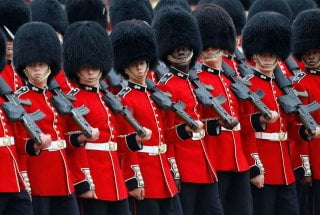Rule Britannia No More: The Five Greatest British Military Failures
Sometimes, the sun does eclipse on the British Empire.
But much of the British disaster was incomprehensible, rather than inevitable. Royal Air Force pilots, cocky from their victory over the Luftwaffe in the Battle of Britain, found themselves outmatched by better-trained Japanese pilots and their deadly Zero fighters. The Japanese force that landed on the Malay Peninsula north of Singapore on December 8 was smaller than that of the defenders, but it outmaneuvered and outfought poorly trained and led British, Australian and Indian troops.
The Japanese were commanded by General Yamashita, victor over the Americans in the Philippines and later to be known as the "Tiger of Malaya." The British were commanded by the lethargic General Percival and his quarreling subordinates.
Yamashita's army was outnumbered almost three-to-one and had to conduct a water assault across the straits separating Singapore from the mainland. The fortress fell within a week, resulting in the surrender of 80,000 prisoners, many of whom would not survive brutal Japanese captivity. Winston Churchill described the surrender of 80,000 men as the worst disaster in British history.
Gazala
The same lethargy that cost Britain its Singapore bastion nearly cost it the Middle East. In the summer of 1942, after Germans, Italians and British had chased each other back and forth across North Africa for nearly two years, the front had temporarily stabilized while both sides prepared for the next round.
With its wide-open, waterless spaces and vast distances between populated areas, the North African campaign was more like naval warfare than the tightly packed mass combat of the Somme or Normandy. Like fleets at sea, armies constantly maneuvered through a barren landscape where most territory had little value in and of itself, barring a few key ports and supply points like Benghazi and Tobruk.
But in mid-1942, the British chose to bring the Maginot Line to North Africa, and with similar results to 1940. The Gazala Line, built near Tobruk, stretched from the Mediterranean coast south into the desert. It consisted of a series of minefields and fortified "boxes" garrisoned by infantry brigades, backed by British armor held in reserve to the rear. Unfortunately, the emptiness of the desert meant that there was no river or mountain to anchor the British defenses, which left a dangling southern flank in the open desert.
Leaving dangling flanks before the Germans was an invitation to disaster, and Erwin Rommel wasn't going to miss this party. Though the British outnumbered Rommel's Afrika Korps and its Italian allies, Rommel characteristically chose to attack on May 27. As should have been expected, he looped his armor around the British southern flank while his Italian cannon fodder (who largely marched on foot in the desert!) diverted the British by attacking their fortified boxes. If all went well, the British boxes would be surrounded and destroyed.
But all didn't go well, and it was Rommel who was in trouble. Square in the path of the German armor was the oasis of Bir Hacheim, held by a very tough Free French brigade of Foreign Legionnaires (plus a detachment of Jewish soldiers). The German armor found itself caught between Bir Hacheim and the British minefields, with their fuel convoys unable to reach the tanks.
The British could have ended the North African campaign then and there if their armor had struck decisively against the isolated German armor. But as at Singapore, British commanders were strangely lethargic, sending their armor in small, uncoordinated packets against the concentrated German defenders. Poor tactics compounded the problem; British tanks attacked without infantry or artillery support that would have neutralized the devastating lines of German anti-tank guns.
Nor did Rommel didn't waste time. He desperately cleared a path for his supply columns, refueled his tanks and scattered the remaining British armor. Glittering before him was the prize of Tobruk, a fortress whose tough Australian defenders had successfully withstood Rommel's siege in 1941. But the defenses were in disrepair, its new South African defenders were unprepared, and the fortress quickly fell with the loss of 30,000 prisoners. Bolstered by massive quantities of badly needed fuel and supplies, the Afrika Korps pressed on to Egypt and nearly to the Suez Canal, only to be stopped at El Alamein.
Coming four months after the fall of Singapore, Tobruk was the low point of British fortunes. After nearly three years of war, the British army proved it still could not take on the Germans in open battle.
And yet, Britain ultimately defeated the Zulus, and the Germans and the Japanese. As the old British saying goes, "We lose every battle but the last one."
Michael Peck is a contributing writer for the National Interest. He can be found on Twitter and Facebook.
This article first appeared earlier and is being reposted due to reader interest. This piece has been updated from its original publication.
Image: Reuters.

